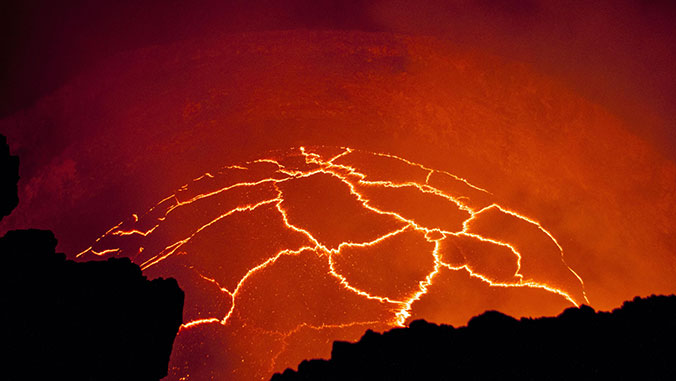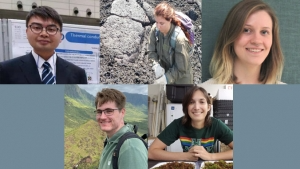Earth Science Students Review ‘Lava Worlds,’ Boost Scientific Writing Skills
In the early solar system, rocky planets, such as Earth, Mercury, Venus and Mars, and the Moon may have been “lava worlds,” with oceans of magma blanketing the surface, according to planetary scientists.
 Halemaumau lava lake in Kīlauea, taken in November 2013. (Photo credit: Tom Shea) Similar magma-covered planets may orbit close to other stars and can be studied directly.
Halemaumau lava lake in Kīlauea, taken in November 2013. (Photo credit: Tom Shea) Similar magma-covered planets may orbit close to other stars and can be studied directly.
Five Earth sciences graduate students in the University of Hawaiʻi at Mānoa’s School of Ocean and Earth Science and Technology (SOEST), along with their Earth sciences professor Eric Gaidos, published a scientific review of this stage in planetary evolution that may determine the later atmospheric composition and potential habitability of planets such as Earth.
Timely scientific review
This topic is particularly timely for the scientific community because NASA’s Transiting Exoplanet Survey Satellite is surveying the entire sky searching for close-in planets around bright stars, including “lava worlds,” and the James Webb Space Telescope, scheduled to launch later this year, will usher in a new era of precise measurements of those objects.
 Student co-authors.
Student co-authors.
“I was interested in writing this paper on lava worlds because planetary volcanology has always been fascinating to me,” said Rebecca deGraffenried, co-author and SOEST graduate student. “It’s always fun to consider a process on Earth, and think about how that process would change under the range of conditions present on exoplanets. Particularly since I started studying Kīlauea, I’ve been interested in lava lakes. So this paper afforded the opportunity to both learn more about lava lakes in general and lava lakes on other worlds.”
Scientific writing course
A critical skill for success in graduate studies and a career in the sciences is clear and concise writing. Courses in scientific writing, such as those taught by Gaidos, are an opportunity for SOEST graduate students to develop their skills and get experience with publication.
This is the fourth time students in Gaidos’s writing class have successfully published their work in an academic journal.
“The introduction to scientific writing was invaluable and something that I was looking for,” said Kelly Truax, co-author and SOEST graduate student. “My first career was a mix of the arts and education, which is a vastly different writing style. It became easier after working on this paper to understand the differences in tonality and structure. The project also offered a unique opportunity to write about subject matter outside of my research and receive feedback from all parties involved.”
This research is an example of UH Mānoa’s goal of Excellence in Research: Advancing the Research and Creative Work Enterprise (PDF), one of four goals identified in the 2015–25 Strategic Plan (PDF), updated in December 2020.
For more information, see SOEST’s website.
–By Marcie Grabowski
Publication: Keng-Hsien Chao, et al. Lava worlds: From early earth to exoplanets. Geochemistry, (2023). DOI: 10.1016/j.chemer.2020.125735
Original Story Source: University of Hawaii at Manoa

 Alerts Sign-up
Alerts Sign-up